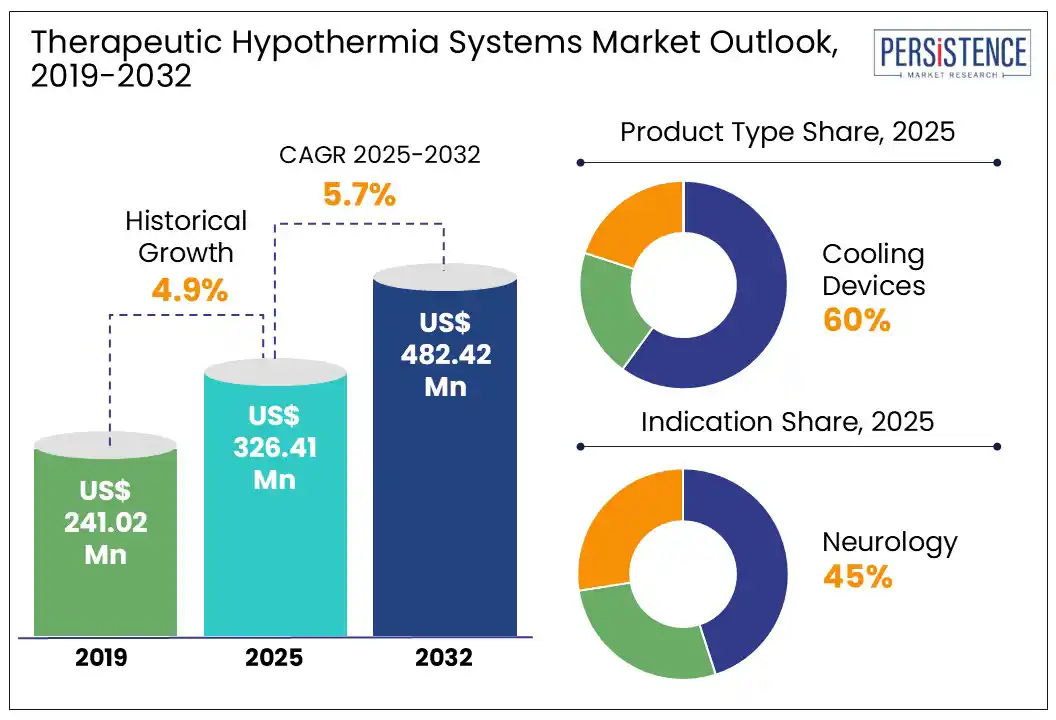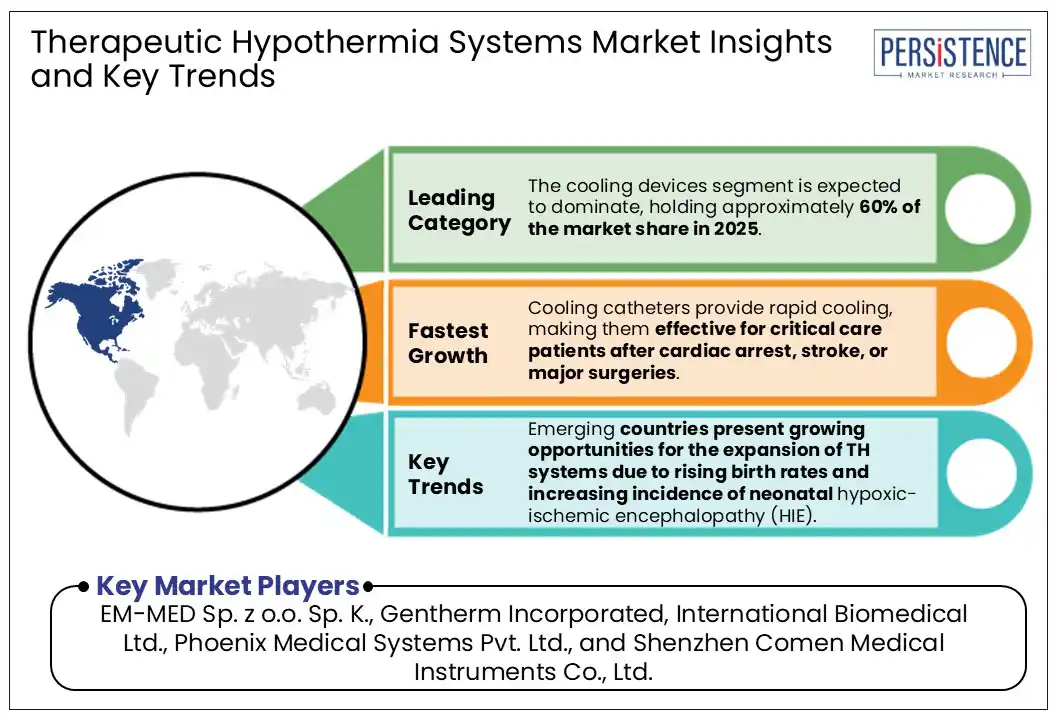ID: PMRREP35502| 183 Pages | 22 Jul 2025 | Format: PDF, Excel, PPT* | Healthcare

The global therapeutic hypothermia systems market size is likely to be valued at US$ 326.41 Mn in 2025 and is estimated to reach US$ 482.43 Mn in 2032, growing at a CAGR of 5.7% during the forecast period 2025 - 2032. Increasing incidence of cardiovascular conditions such as myocardial infarction (MI) and cardiac arrest, growing number of surgical procedures, and increasing use of minimally-invasive medical cooling methods are major growth indicators.
Therapeutic hypothermia (TH), also known as targeted temperature management or induced hypothermia, involves lowering a patient's body temperature for a specific period to improve neurological recovery and reduce tissue damage. This helps in reducing mortality after global cerebral ischemia or traumatic neurological injury, such as in patients with cardiac arrest, and in infants with moderate or severe HIE. Surface cooling systems, including blankets, pads, ice packs, and endovascular cooling systems are also forms of TH systems.

Key Industry Highlights:
|
Global Market Attribute |
Key Insights |
|
Therapeutic Hypothermia Systems Market Size (2025E) |
US$ 326.41 Mn |
|
Market Value Forecast (2032F) |
US$ 482.43 Mn |
|
Projected Growth (CAGR 2025 to 2032) |
5.7% |
|
Historical Market Growth (CAGR 2019 to 2024) |
4.9% |
Surgical procedures are on the rise globally, now exceeding 310 million annually, around 40 to 50 million in the U.S., and 20 million in Europe. Modern therapeutic hypothermia systems use closed-loop feedback control with real-time temperature monitoring, allowing clinicians to maintain a precise temperature among patients. This ensures safer and consistent cooling both during and after surgery, reducing complications such as hypothermia-related bleeding, infection, and prolonged recovery. The introduction of non-invasive surface cooling technologies, such as cooling pads, blankets, and head caps, has improved patient comfort, simplified applications in clinical settings, and is fully compatible with sterile surgical environments such as operating rooms and ICUs.
Precise temperature control minimizes risks, such as bleeding, infection, and shivering, leading to faster recovery and shorter hospital stays. AI-driven hypothermia systems offer personalized cooling algorithms, integration with vital signs and EEG, and remote monitoring. Elevated body temperature during surgery can increase the risk of surgical site infections, disrupt blood coagulation, raise metabolic demands, and cause cardiovascular stress, neurological damage, and delayed recovery. Failure to maintain proper temperature regulation may lead to shivering, discomfort, prolonged hospital stays, worsening patient outcomes, and increasing healthcare costs.
TH systems can cause side effects such as shivering, infection risk, electrolyte imbalances, and skin injuries from cooling devices. TH is also associated with rewarming injury, shivering, electrolyte imbalances, pharmacological and pharmacodynamic alterations, and cardiovascular effects (arrhythmias, bradycardia, and insulin resistance). It can also lead to infections such as pneumonia, bloodstream infections, and catheter-related infections, which are seen in up to 67% of patients treated with hypothermia after cardiac arrest. Hypothermia impairs immune function by suppressing proinflammatory cytokines, leukocyte migration, and phagocytosis, and may promote hyperglycemia through insulin resistance, further increasing susceptibility to infections.
Implementing therapeutic hypothermia requires specialized equipment and trained personnel, leading to significant costs. Commercially available servo-controlled cooling, which precisely regulates patient temperature through automated feedback systems, can be expensive, limiting its use in resource-constrained settings. These devices often require significant capital expenditure, ongoing maintenance, and consumables such as cooling pads or catheters, adding to operational costs. Effective TH administration also demands a skilled multidisciplinary team, including trained nurses, physicians, and technicians familiar with temperature management protocols, monitoring techniques, and complication management, adding to the expense.
Emerging countries present growing opportunities for the expansion of TH systems due to rising birth rates, increasing incidence of neonatal HIE, expanding access to critical care, and improving healthcare infrastructure. With over 90% of global neonatal deaths occurring in low- and middle-income countries (LMICs), there is a pressing need for affordable interventions such as TH that can reduce mortality and long-term disability. Low-cost cooling devices (ice packs, phase change material mattresses & simplified servo-controlled systems), have demonstrated feasibility for TH implementation even in resource-limited facilities. Support from global health organizations and public-private partnerships (NGOs) is also driving technology transfer, training programs, and equipment subsidies.
Access to advanced cooling equipment is limited due to high costs and supply challenges, particularly in sub-Saharan Africa and South Asia rural hospitals. Many healthcare facilities lack trained personnel familiar with TH protocols, and often do not have the infrastructure for continuous core temperature monitoring, increasing the risks. To address these challenges, a Global South Alliance has been formed to prevent neurodisability in LMICs. The alliance focuses on conducting research that fits local needs, strengthening clinical & research skills, and collaborating on the creation of international guidelines suited for settings with limited resources.
By product type, the cooling devices segment is expected to dominate the TH systems market, holding approximately 60% of the market share in 2025. The cooling devices segment includes a range of non-invasive technologies such as surface cooling blankets and pads, cooling helmets or head caps, and circulating water or gel-based systems. These devices require less specialized training and are cost-effective, making them suitable for varied clinical settings, including emergency rooms and ICUs. Pluss Advanced Technologies in India manufactures the MiraCradle, a low-cost & power-free device successfully used in over 125 hospitals with promising outcomes, including a documented case in Indore where a neonate recovered fully after therapeutic hypothermia.
The cooling catheters segment is expected to be the fastest-growing over the forecast period. Cooling catheters (surface cooling and endovascular) are invasive devices used in TH to induce and maintain precise core temperature control by circulating cooled fluids through a catheter inserted into large central veins, including the femoral or subclavian vein. The most common types are endovascular cooling catheters that connect to external temperature control units, circulating chilled saline or coolant, and multi-lumen catheters that allow simultaneous cooling and medication administration. These catheters are highly effective for critical care patients after cardiac arrest, stroke, or major surgeries.
By indication, the neurology segment is expected to dominate the TH systems market in 2025, accounting for around 45% of the market share, driven by the increasing prevalence of neurological disorders such as ischemic stroke, traumatic brain injury, and neonatal HIE. According to the October 2024 CDC data, in the U.S. in 2022, stroke accounted for one in six cardiovascular deaths, with over 795,000 people experiencing a stroke annually, about 87% of which were ischemic. Advancements in clinical studies and multicenter trials have demonstrated the efficacy of therapeutic hypothermia in reducing neuronal damage and improving neurological outcomes, thereby accelerating its adoption in neurology departments worldwide.
The cardiology segment is poised to be the fastest-growing over the forecast period, driven by a significant incidence of cardiac arrest cases. According to 2025 Global Heart & Circulatory Diseases Factsheet, there are around 640 million people living with heart and circulatory diseases across the world. TH has been shown to improve survival and neurological outcomes in patients who have experienced out-of-hospital cardiac arrest, leading to its widespread adoption in emergency care protocols. Advancements in cooling technologies and the development of user-friendly and cost-effective devices have facilitated the integration of TH into clinical practice, particularly in cardiology departments.

North America is estimated to dominate the market in 2025, accounting for a market share of approximately 45%, driven by a high prevalence of neurological and cardiovascular diseases such as stroke, cardiac arrest, and traumatic brain injury. Advanced healthcare infrastructure, significant investments in medical research, and rapid adoption of innovative cooling technologies contribute to this region’s leadership. The cooling devices segment holds a substantial share of the market due to its non-invasive nature and ease of use, while cooling catheters are gaining traction in critical care.
The U.S. is experiencing a high growth, driven primarily by the occurrence of approximately 795,000 strokes and about 356,000 out-of-hospital cardiac arrests reported annually, fueling demand for therapeutic hypothermia interventions. The country’s advanced healthcare infrastructure, featuring more than 6,000 hospitals and over 1,000 accredited stroke centers, supports widespread adoption of hypothermia protocols. Major players are Medtronic, ZOLL Medical Corporation, Becton, Dickinson and Company, Stryker Corporation, and Philips Healthcare.
Asia Pacific is experiencing rapid growth due to the increasing prevalence of cardiovascular and neurological disorders, such as stroke and ischemic heart disease, prevalent in countries including China and India. Additionally, the region's aging population and rising healthcare expenditures are contributing to the demand for portable and non-invasive cooling devices. India’s REVIVE system, developed by Sensivision Health Technologies, a Bangalore-based health-tech startup, is a low-cost, servo-controlled whole-body cooling device with integrated AI-enabled cerebral monitoring that automates neonatal hypothermia therapy to effectively regulate temperature and brain activity while minimizing clinician intervention.
China is projected to dominate the market over the forecast period. The National Health Commission of China reported a significant rise in tertiary care facilities, with Class III hospitals increasing from 2,200 in 2018 to over 2,800 by 2023, enhancing the capacity to implement advanced medical treatments such as TH. Additionally, the integration of AI into therapeutic hypothermia systems is improving the precision and effectiveness of treatments, further driving market growth.
The therapeutic hypothermia systems market in Europe is projected to grow at a steady rate over the forecast period, driven by advancements in medical technology, increasing awareness about the benefits of therapeutic hypothermia, and a rising incidence of cardiovascular and neurological disorders, especially due to the higher presence of the geriatric population. In the U.K. The National Institute for Health and Care Excellence recommends therapeutic hypothermia for adults after out-of-hospital cardiac arrest with a shockable rhythm. The European Union actively funds collaborative research projects under programs such as Horizon Europe, supporting the development of advanced cooling technologies, AI integration, and clinical trials on hypothermia applications.
The therapeutic hypothermia systems market in Germany is expected to lead within Europe, supported by its advanced healthcare infrastructure and a supportive regulatory framework. German hospitals increasingly adopt cooling catheters, especially in post-cardiac arrest care, due to their precision in temperature control and clinical efficacy. The integration of AI and ML enhances real-time monitoring and personalized treatment plans, improving patient safety and outcomes. The Institute for Quality and Efficiency in Health Care (IQWiG) supports therapeutic hypothermia for post-cardiac arrest care, and it is reimbursed under the statutory health insurance system as part of standardized treatment protocols.
The global therapeutic hypothermia systems market is highly competitive, driven by the rising incidence of neonatal HIE, cardiac arrest recovery needs, and neuroprotection in surgical settings. Leading players include Zoll Medical (a subsidiary of Asahi Kasei Corporation), Philips Healthcare, Becton Dickinson (BD), and Medtronic. Companies are investing in R&D and adopting growth strategies such as product innovations, strategic partnerships, and acquisitions.
The therapeutic hypothermia systems market is projected to be valued at US$ 326.41 Mn in 2025.
The market growth is driven by increasing incidence of cardiovascular conditions such as MI and cardiac arrest, growing number of surgical procedures, and increasing use of minimally invasive cooling methods.
The therapeutic hypothermia systems market is poised to witness a CAGR of 5.70% from 2025 to 2032.
Emerging countries present growing opportunities for the expansion of therapeutic hypothermia systems due to rising birth rates and increasing incidence of neonatal HIE.
Major players include EM-MED Sp. z o.o. Sp. K., Gentherm Incorporated, International Biomedical Ltd., Phoenix Medical Systems Pvt. Ltd., and Shenzhen Comen Medical Instruments Co., Ltd.
|
Report Attribute |
Details |
|
Historical Data/Actuals |
2019 - 2024 |
|
Forecast Period |
2025 - 2032 |
|
Market Analysis |
Value: US$ Mn |
|
Geographical Coverage |
|
|
Segmental Coverage |
|
|
Competitive Analysis |
|
|
Report Highlights |
|
|
Customization and Pricing |
Available upon request |
By Product Type
By Application
By End-user
By Region
Delivery Timelines
For more information on this report and its delivery timelines please get in touch with our sales team.
About Author